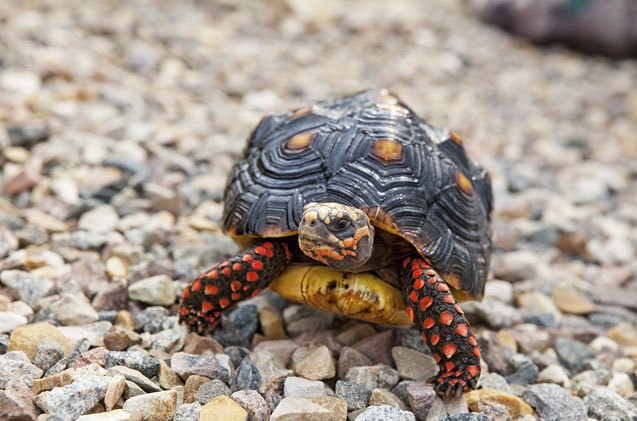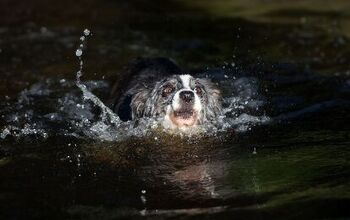Red Footed Tortoise


About Red Footed Tortoise
The Red Footed Tortoise is one of the most popular tortoise breeds kept as pets. These pets are easy to find, as large-scale breeding is available in the United States, and you can acquire captive-bred Red Footed Tortoises from a variety of sources, including reptile expos, breeders, and pet stores.
Pet owners also like the Red Footed Tortoise because these animals are easy to care for. Their size is easy to handle, and they’re beautiful to look at, thanks to the lovely colors on their shells, legs, and head. They also have a curious personality, and they’re a good choice for beginners.
The Red Footed Tortoise is one of the most popular tortoise breeds kept as pets.
The Red Footed Tortoise is found in grasslands, savannah, and dry forest areas. However, they might also be seen in rainforests that are located near open habitats.
These animals are native to southern Central America, as well as much of South America.
The Red Footed Tortoise features a carapace that’s oval, a relatively small head, and large eyes. Also, the carapace is fairly highly domed, and the scutes might be raised or smooth.
The marginals will appear as those they’re tucked under the sides, but will also flare a bit over the limbs. You’ll even notice growth rings that are evident as your tortoise grows, but these could become smooth as your pet ages.
The skin of the Red Footed Tortoise is mostly black. The carapace will be gray, black, or brown. There will also be small areas of tan or yellow coloring that surrounds or covers every bump on the carapace.
You’ll also notice that there are a few bright red scales or marks on the lower jaw and head of this tortoise. The tail and the legs usually have scales or patches that are yellow, red, or orange.
This tortoise’s plastron will be black, brown, or a dull yellow color.
Pet owners like the Red Footed Tortoise because these animals are easy to care for.
The enclosure for your Red Footed Tortoise will need to have sturdy walls that are a minimum of 16” above the ground. The walls should also be a few inches below the ground in order to discourage and prevent your tortoise from trying to dig his way out. Don’t use fences or walls that your tortoise will be able to see through because he’ll try to escape if he can see what’s on the other side.
If you have a young Red Footed Tortoise, you can raise him indoors, especially if the outdoor conditions aren’t tolerable. Overall, outdoor enclosures are preferred for adults, as long as the temperatures are acceptable. When outside, these tortoises are tolerant to high temperatures if they have shaded spots and access to water. They can also handle cooler temperatures down to 45°F, but you should provide a heated hiding box that’s in the 70s Fahrenheit, especially at night.
When housing this tortoise indoors, it’s best to utilize a tortoise table that you can build yourself or purchase, or a plastic sweaterbox. Inside this enclosure, there should be substrate, hiding places, heating, and lighting.
Good substrate options include cypress mulch, coconut coir, and peat moss. As long as your soil isn’t contaminated with fertilizers or chemicals, you can use it for your turtle’s outdoor enclosure. Also provide several large, flat rocks, as these will be a great surface on which you can place food for your pet, and your tortoise can file his nails down using these rocks as well.
The humidity level should be moderate inside your tortoise’s enclosure, so mist it regularly. A baby tortoise should have access to a hiding area that’s humid. This will allow him to burrow and snuggle in to get the humidity necessary for his shell to grow properly, as well as to remain hydrated.
Maintain the temperature of your indoor tortoise enclosure at 68-80°F, and have a basking area of around 90°F. UVB lighting should be provided to tortoises that aren’t exposed to sunshine, and the lights can run for 12 hours each day.
Finally, your tortoise should always have a shallow dish filled with filtered water so he can soak in it and drink from it.
The Red Footed Tortoise has a curious personality, and is a good choice for beginners.
The Red Footed Tortoise is an omnivore, so you need to provide a varied diet.
You can feed your tortoise vegetables that include turnip greens, watercress, dandelion greens, escarole, broccoli, mustard greens, collard greens, Swiss chard, kale, parsley, romaine, cooked sweet potatoes, squash, parsnips, pumpkin, zucchini, peas, carrots, and bell peppers. Avoid pale colored greens like celery and iceberg lettuce. Other good plant options include rose blossoms, hibiscus flowers, and other non-toxic flowers and leaves.
Fruit that you can offer include berries, apples, papaya, melon, pineapple, guava, cactus fruit, bananas, plums, grapes, tomatoes, and peaches.
A small part of your pet’s diet should be animal protein. Stick with low fat sources, and feed these foods once a week. Good options include roaches, crickets, mealworms, bloodworms, waxworms, and earthworms.
You can also supplement your tortoise’s diet with a multi-vitamin/mineral and calcium product.
Red Footed Tortoises shouldn’t be handled regularly, as they can become stressed. However, these tortoises are a pleasure to watch, and their curious personalities are certainly endearing.
Photo credit: Life on White/Bigstock; praisaeng/Bigstock; songbird839/Bigstock

Lisa Selvaggio is a freelance writer and editor, and our resident cats-pert, with certifications in pet nutrition and pet first aid. She enjoys producing content that helps people understand animals better so they can give their pets a safe and happy home.
More by Lisa Selvaggio

























